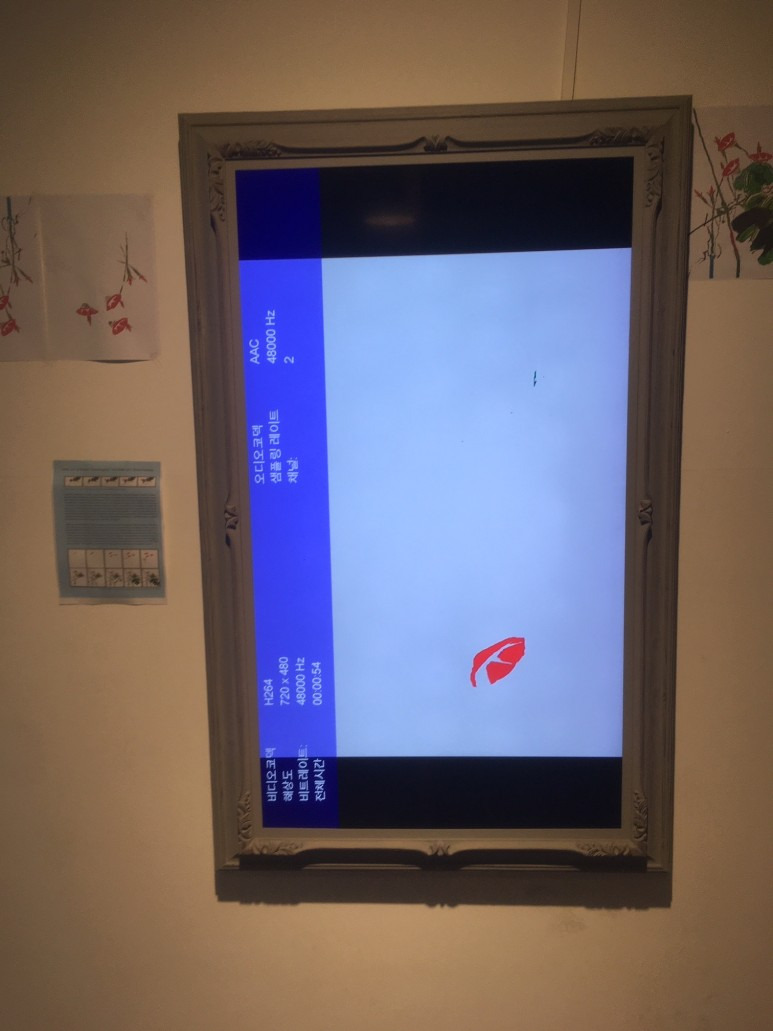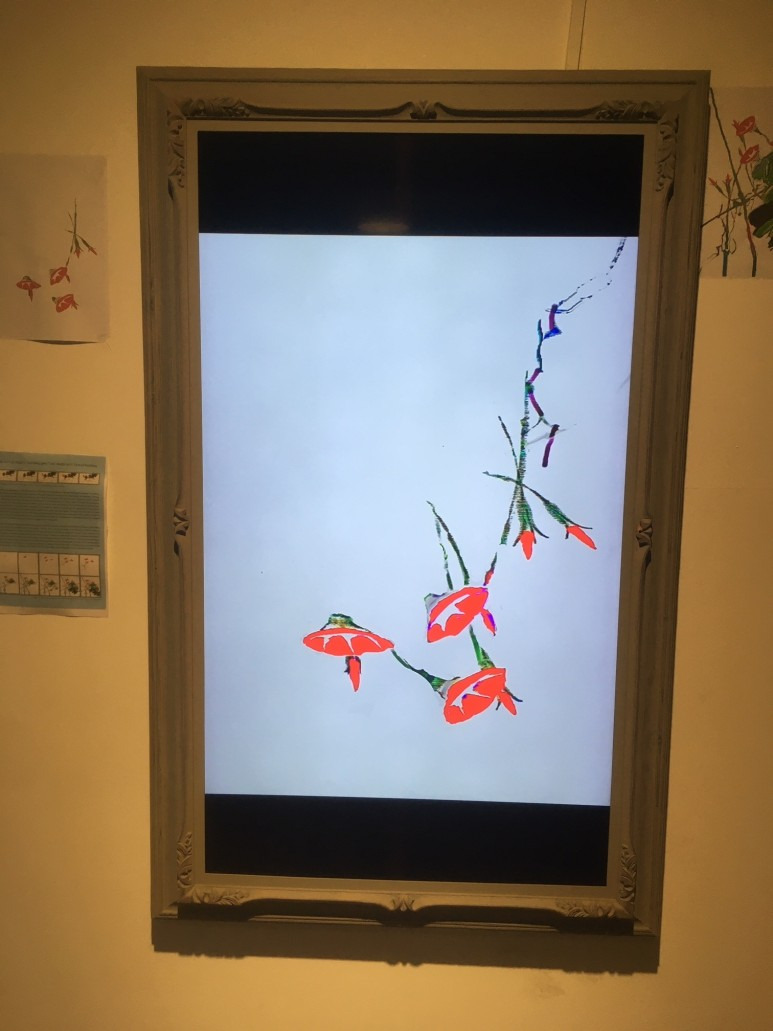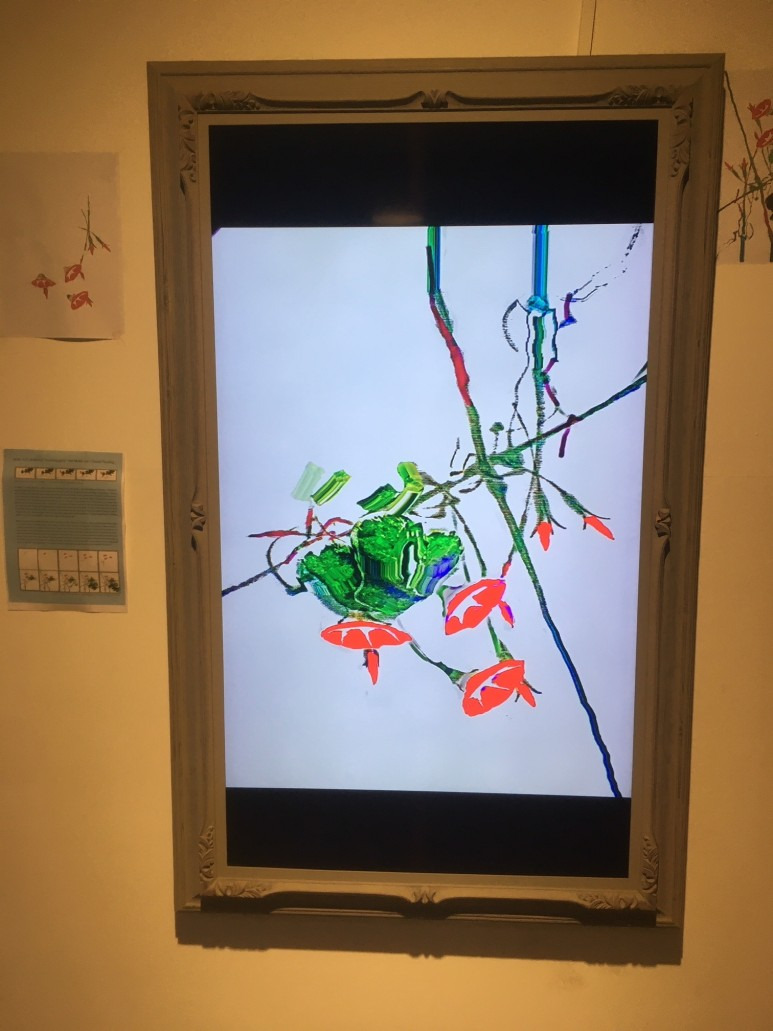현대미술가 최철주 [21] 현대미술평론 현대미술가평론 개념추상리얼리즘화가평론 현대미술추상화가작품평론: 현대미술가 및 현대 개념추상리얼리즘 화가의 개념추상 리얼리즘작품 평론./ 추상디자인 프로세스 : 현대개념추상예술로서 시각예술이론을 통해 미적가치의 예술성을 검토하고 현대개념추상화가이자 비평가인 최철주는 그의 「morning glory」 작품을 통해 종종 추상적인 욕망 개념과 언어적 의미 구조를 반영하여 지각과 미적 구조를 해석하고, 그 결과로 추상적 욕망의 언어적 의미와 동일한 실재 이미지의 추상화로 귀결된다.
Contemporary Artist Choi Chul-joo, as conceptual abstract realism painter [20] Contemporary Art Today, Contemporary Art Critic Choi Chul-joo's Criticism of Contemporary Art Writers and Contemporary Concept Abstract Realism Review: Contemporary Art Critic Louis Choi Chul-joo (https://opensea.io/Louisland) & Contemporary Concept Abstract Realism Design Criticism./ Design Process of Contemporary Artist and Contemporary Concept Abstract Painter Concept Abstract Art Work Critique: As Contemporary Concept Abstract Art, the artistry of aesthetic value was examined through visual art theory, and Choi Chul-joo, a Contemporary Concept Abstract Painter and Critic, was his Through "morning glory" works, perceptions and aesthetic structures are often interpreted by reflecting abstract conceptions of desire and linguistic semantic structure, resulting in abstraction of the same real image as the linguistic meaning of abstract desire./ Abstract art criticism: contemporary artworks contemporary artist Louis Choi Chul-joo "morning glory" & thread painting: morning glory, 20201126-20201210, Minoo Media Art Museum
미디어 아티스트 루이 최철주 개인전/ 미디어아트 영상전시 Media Artist & Contemporary installation artist Louis Chul-joo Choi’s Media Art Video Display: <나팔꽃>,20201126-20201210, Minoo Media Art Museum
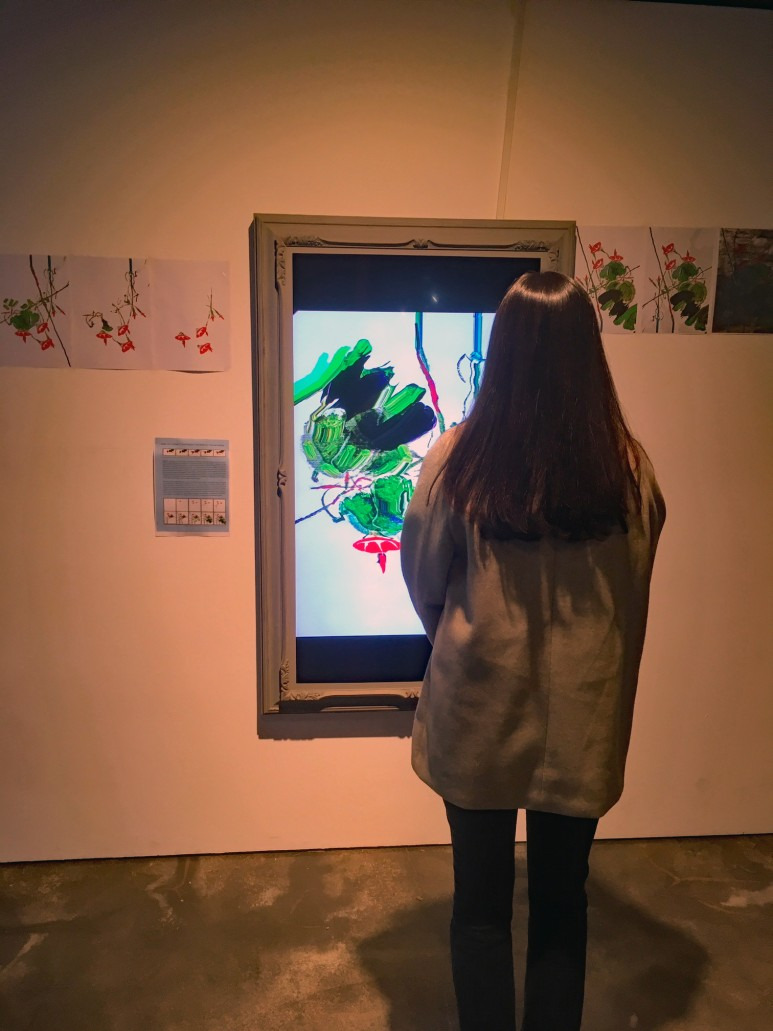
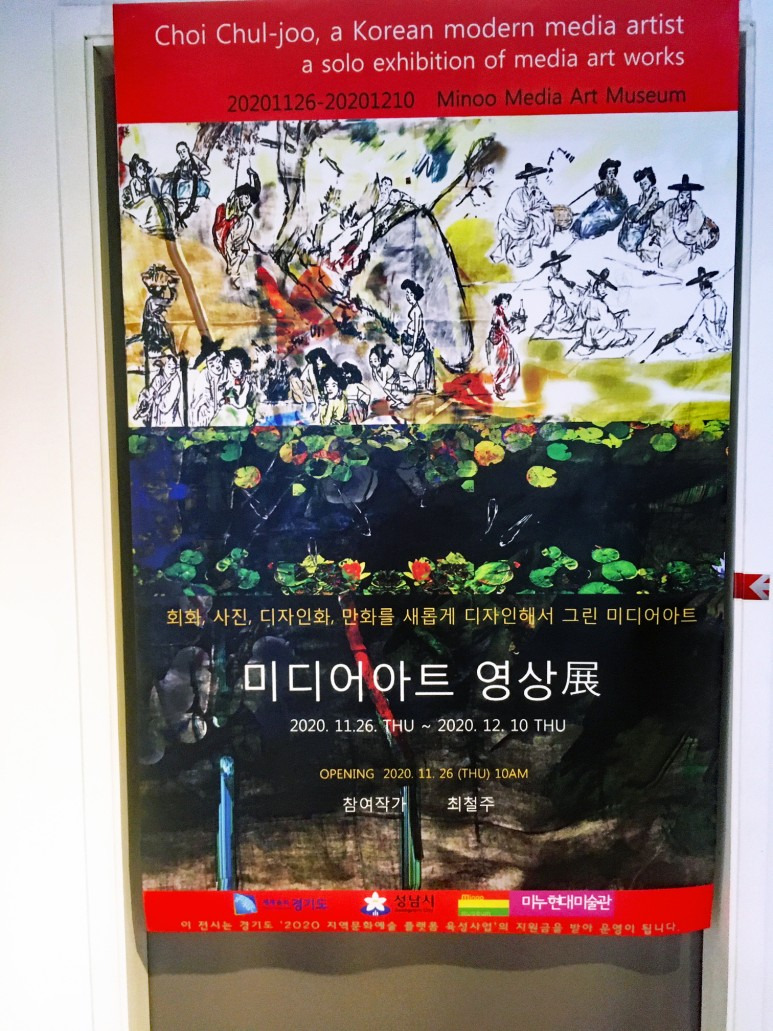
미디어 아티스트 개념 이미지 설치 미술가 작품 루이 최철주 개인전 미디어아트 영상전시 Media Art conceptual artist Louis Chul-joo Choi’s Media Art Video Display: <최철주 나팔꽃>, <사라진 연못>, <대나무 숲>, <신윤복풍주밀회도(申潤福風晝密會圖)=최철주의 송하선인취생도>, 20201126-20201210, Minoo Media Art Museum

2020년 미누현대미술관 학예실장으로서 문화디자인박사 최철주는 미디어아트를 창작하는 과정에서 미디어아트 작품과 그 이미지를 새롭게 디자인했다. 최철주의 미어어아트 <나팔꽃>은 꽃의 자리를 디자인하고서 그 꽃의 형태에 의존하는 잎과 줄기의 자리를 정한다.
따라서 꽃의 구도로서의 줄기를 꽃에 맞춘다. 전체 이미지에서 줄기와 잎의 구조로 꽃을 그리는 과정을 보여주는 미디어아트 제백석의 <나팔꽃>과 달리 나팔꽃의 꽃을 시작으로 나머지 구조를 디자인한 미디어아트는 디자인박사 최철주의 <나팔꽃>이다. 그는 발묵(潑墨)적 우연성으로한 정해진 존재에 의존하는 꽃의 자리를 디자인한다. 이것은 대기(大氣)의 묘사 없는 미디어아트와 페인팅에 실제화한다. 여기서 기계적으로 재현되는 오리지널 미디어아트를 제작하는 과정에서의 그림 형식이 쓰레드 페인팅(thread painting)이다.
이 그림은 물체를 마주보는 과정에서 빛의 부피를 자수하고 물체의 그림자를 관념적으로 묘사하고 있다. 이것은 동양적 자수와 수묵화를 결합한 새로운 회화적 프로세스에서 '한 획'을 강조하는 선형예술이다. 즉 미디어아트 “나팔꽃”이 그려지는 과정의 동영상에서의 정지된 ‘한 획’을 천에 실과 페인트로 그려낸 것과 같다. 미술평론가 최철주는 김홍석 “개폐”에 대한 미술평론에서 쓰레드 페인팅에 대한 정의를 “시간에 조응된 물감과 실이 드러남과 여백을 천에 남긴 흔적이다.”라고 했다.

Louis, morning glory 2022-c, 135X156cm, acrylic and composite materials on cloth, 2022
또한, 그는 쓰레드 페인팅에서 조형의 구조를 “형상을 구성한 실은 대상을 설명하지 않고 연쇄된 실이 조형적 구조가 되면서 조형적 의미의 효과를 보인다. 이것은 색의 의미가 소급되어서 실에 색이 교직된 회화적 구조다.”라고 했고, 그것의 미적 가치는 “사물을 지각하는 방법을 그가 깨닫기 전에 구체화한 선관(先觀)적 자의식의 한 형태다. 그 조형의 색은 시간의 거리를 주어서 표식하지 않고 퇴색된 본디의 조형의 구조로 간주되어 보임으로서 숨겨져 있는 미적 가치를 드러낸다.”라고 했다. 이것은 M.뒤샹의 물질을 치장하지 않는 개념미술의 미학과는 다르다. 쓰레드 페인팅은 사물을 지각하는 방법을 깨닫기 전에 구체화한 선관(先觀)적 자의식의 한 형태다.

최철주 쓰레드 페인팅 <나팔꽃 2022-c> 뒷면
그 형태의 색은 시간의 거리를 주어서 표식하지 않고 퇴색된 본디의 조형 구조로 간주하여 보임으로서 숨겨져 있는 미적 가치를 보인다. 그리고 개념미술의 문학성을 넘어서 회화로서 조형성을 비등(沸騰)하고서 남겨진 색을 그려서 새로운 조형의 구조로서 실로 매듭한다. 그 색의 구조를 실에 넣어서 색을 가려 막는 매듭으로서의 조형을 특정한 색에 조응할 수 있도록 선형적 구조의 색이 존재한 조형을 구성한다. 따라서 ‘쓰레드 페인팅’은 개념미술의 지나친 문학성을 부정하는 선형적 미학을 추구하는 천에 실과 페인트를 칠한 그림이다.

최철주 쓰레드 페인팅 <나팔꽃 B-00-2>/ thread painting: Louis Choi Chul-joo <Choi Chuljoo thread painting Morning glory>
최철주 쓰레드 페인팅 <최철주 나팔꽃>은 풍습에 의해 만들어진 대상의 천과 같은 재료에 그려진 이미지다.
그 <최철주 나팔꽃>은 라캉적 이미지처럼 대상이 보이는 형상을 천과 같은 재료에 구성하여 좌우가 역전된 이미지를 그리는 방식이다. 따라서 그의 그림은 앞면과 뒷면을 구분하지 않는 양면의 그림이다. 실제적 형상과 응시적 형상에서 주제에 어울리는 피상(皮相)적 면으로 이미지를 표상한다. 여기서 풍습의 변화 대상으로 그림을 그리는 것은 하나의 대상으로 보이는 또 다른 이미지다. 그것은 공간에서 보이지 않는 작은 조각으로 그려진 대상의 물질로 감추어지고 사라진다. 대상의 작은 조각은 그 형상의 실제로 바꾸는 기표적 의중 운동을 통해서 가역된 실제 공간을 보인다. 이것은 어떤 형상의 의미를 가리키며, 그 작은 대상은 실제 가역할 수 있는 공간을 정의하고 형상의 실제 변화된 움직임에 의해 가려지는 형상의 의미를 가리킨다. 그것은 천과 같은 재료에 주재(主材)된 형상과 빛의 색깔로서 인상적 공간의 필연성으로 한 대상의 자리를 정한다.
그리고 그 자리의 빛과 대상을 멈추게 하여서 풍습 된 페인팅의 구조를 이룬다. 이것은 순간적으로 멈추어선 그 구조의 필연성으로 한 주재적 공간이다. 따라서 그림의 실제적 구조로서 형상이 멈추었던 자리에서의 의미가 가역적 사고 운동으로 형성된다. 이것의 구조로서 의식되는 의미가 공간의 자리를 찾아가는 작은 조각일 뿐이다. 그 작은 조각은 유사한 대상일 때 많은 공간의 자리에서 현상적 물성으로 공존한다. 그 자리 하나의 현상과 다른 의미가 교차하는 의중 운동으로 여러 개의 공간 속으로 그 자리가 끼워진다. 이것은 자리의 공간 안에서 의중 운동으로 또 다른 자리를 연쇄하여서 만들어낸 쓰레드 페인팅 <나팔꽃>이다. 여기서 공간의 자리는 사라지고 그곳에 자리했던 나팔꽃은 빛의 색깔로 변신한다.
그러나 빛의 형상이 그림의 의미 효과로써 지난 공간에서 사라진 천과 같은 재료에 빛의 색깔로 그림 선택한다. 여기서 그림은 나팔꽃의 표면을 빛과 연결하는 공간 안에서 그 빛을 선으로 바꾸어 이미지를 왜곡시킨다. 따라서 보이지 않는 선 공간의 구성은 꽃을 그릴 수 없으므로, 2020년 미누현대미술관 미디어아트 영상전에서 <최철주 나팔꽃>의 시작 화면은 도입부 공간으로서의 실제 구조가 아니므로 줄기와 잎을 스케치하고 꽃을 그려가며 선 공간을 구별한다.
정지된 미디어아트에서 대상을 구별하는 빛의 모양을 실로 그려낸 것이 쓰레드 페인팅이다. 이것은 풍습 된 대상을 구도로 한정할수록 공간을 이어주는 대상의 자리가 빈자리가 되기 때문에 스케치 위에 시침질 선으로 한정된 구조로서 자리에 숨겨진 천의 내면을 치장하여서 예술적 형상의 작은 조각으로 공간의 의미를 찾는다.

이렇게 <최철주 나팔꽃>은 천과 같은 재료에 그린 그림으로써 대상의 필연적 공간성으로 한 추상적 자리를 구성함으로써 실제의 풍습 된 회화 예술로서의 미적 가치를 획득한다.
또한, 회화성에 기반을 둔 원본성과 프로세스 미디어아트의 형상성을 가지고 미디어아트 이미지로서의 스틸 영상을 시간성에 맞추어 그려내는 쓰레드 페인팅은 원작의 또 다른 독창성을 가진다. 이것은 모니터로 보이는 콘텍스트(con·text)로써 정지된 각각의 영상 이미지를 쓰레드 페인팅으로 그려낸 원화이기 때문이다. 그것은 페인팅과 같은 예술적 의미가 있는 조형적 쓰레드 이미지로서 다양한 전시성을 가진다.
전시 공간의 자리에서의 물리성에서 가역된 시간성은 빛의 색깔로써 자리를 만들고 그 자리의 빛의 색으로 인식된다. 추상적 빛의 공간은 물질적 대상의 구조를 엿볼 수 있지만, 그 자리는 대상의 주체가 그 시간성의 변화에 따르는 공간의 여백이 된다. 그 여백은 추상적 공간이지만 페인팅의 주체가 말하는 가역된 빛의 색깔로 그려짐에 따라 그 여백에 숨겨진 대상의 자리를 만든다. 이것은 페인팅이 대상에 대하여 공간의 빛을 형상화한 이미지와 일치되도록 대칭적인 공간의 필연성에 따라서 정해진 대상이 자리다.
대상에 맞춘 이미지의 공간은 여백의 형식으로 한 간극을 천으로 이어진 분리된 공간을 만들고 그 천의 위에 그려진 색채가 여러 개의 빈 공간을 하나의 그림 구조로 교직 된 천과 같은 재료에 그려진 그림의 구조다. 그 이미지는 대상의 자리가 정한 색채와 형상에 따른다.
따라서 그 이미지의 색깔은 대상과 마주했던 풍습적 보편성의 실제를 빛의 색깔로 꾸민다. 이렇게 꾸며진 형상의 빛과 대비되는 어두운 여백의 공간은 주재(駐在)로 만들어낸 그림자다. 여기서 실제의 대상적 존재로서 색깔은 응시로 보이는 풍교된 풍습의 단상이다. 그 단상은 일상적 삶의 장소에서의 멈춘 깨달은 물체의 형상을 빛의 색깔로써 형식을 갖추고 분간하기 어려운 반사적 여백의 색깔을 천과 같은 재료에 그린 그림을 연쇄하여서 하나의 그림을 그려낸 것이다. 여기서 색칠된 그림은 관습에 의해 깨우치거나 제자리에 있을 때 색의 형상으로 현실의 존재를 풀어낸다.
그러나 여백의 빈 공간은 시간성을 재현할 수 없어서 대상의 주체에 어울리는 색깔로 보인다. 그리고 그 색깔에 대비된 색점으로 천과 같은 실에 형상의 윤곽을 정한 <나팔꽃>은 지난 공간의 필연성으로 풍습의 친숙함을 포착한다.
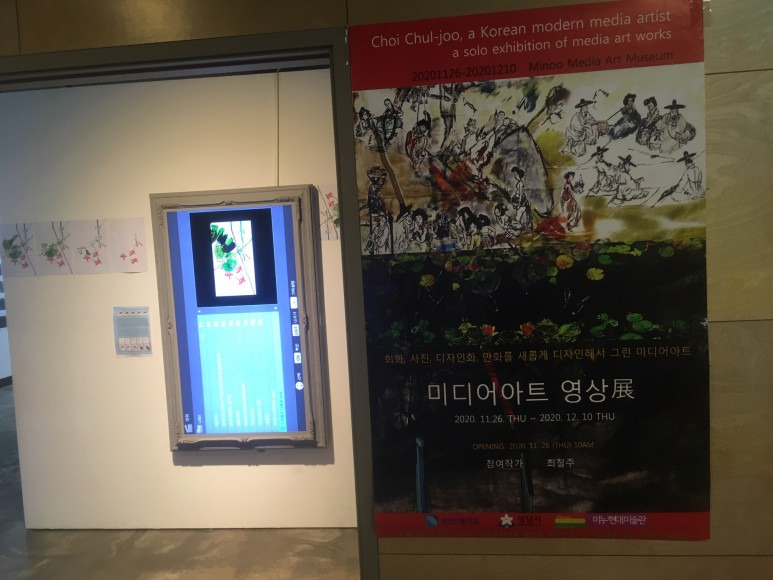
개념미술 추상 미디어아트 : Louis Chul-joo Choi, Media-art: <Choi Chuljoo Morning glory>
현대 미디어 아티스트 & 개념미술가 최철주의 현대 추상 개념미술은 초기 개념미술의 개념으로 한 회화성의 복귀다. 즉 회화 작품으로 생성하는 개념미술이다. 따라서 그의 현대 개념미술은 시사만평처럼 현상적 이미지를 비판하지만 회화성으로 의미적 가치를 말한다.
미술품에서 Ready made 기성품이 회화성을 대신할 수 없고 Marcel Duchamp 뒤샹처럼 창조된 개념과 그의 동조자 Joseph Kosuth 조셉 코수스가 말한 철학에 따른 메시지를 말한다. 반면에 라캉 미술이론에서의 유아적 상상계의 허상을 개념으로서 최철주의 개념미술은 시사만평으로 개념의 의미를 라캉적 회화속에 메시지를 담는다. 그것은 사건의 현장 사진을 만평으로 비판적 시각과 라캉적 회화의 삶적 가치를 교합시킨다.
이것은 수학적 개념과 철학적으로 의미화한 언어적 해석을 넘어서 사건의 현장 사진을 만평으로 비판적 시각과 라캉적 회화의 삶적 가치를 교합시킨다. 여기서 미디어아트 <최철주 나팔꽃>의 스틸 이미지로서 라캉적 추상화는 임의적인 철학성보다는 타자의 욕망을 응시로서 순간적으로 이성적 지각할 수 있는 회화성을 보인다.

Louis Chuljoo, Thread Painting: morning glory 2020-b , 135X156cm, acrylic and composite materials on cloth, 2020
morning glory B-00-2-2
Art Review: Media Art's Qí Báishí's "morning glory" and Media Art's Thread Painting; Contemporary artist Louis Chul-joo Choi’s "morning glory", 2020, Museum of Minoo media art museum

Qí Báishí's Media-art "morning glory", Still image(4, 10, 23, 30, 39sec), Collection of Minoo Media Art Museum,
Qí Báishí's "morning glory" is a simple, linear form that aligns the bright shade of light with the leaves and stems. He collects aesthetic results that affect humans so that the morning glory does not deviate from its actual shape. His paintings, "morning glory" consists of the effect of ink-and-washy tea, which sets flowers straight to the top of the stem. He gives a humorous touch to the difference in brightness, allowing the morning glory to be distinguished as a living object. He added the movements of the flowers in an anomalous way to his painting of the morning glory. His painting of the morning glory is arranged with leaves, and the stem forms the entire composition. He equates the leaves and stems with the appearance of the morning glory tailored to the flowers, thus establishing a position that humans can understand. The joint of the stem falls into black ink and the stem connected to it is thin and cloudy, and overlaps with the space as an impression effect of black ink with no boundary line with the morning glory. And the shape of the leaves drawn by the difference in brightness of black ink is shaped and structured so that humans can rely on the shape of the morning glory.
Media art at the Minoo Media Art Museum has cast doubt on the production process by showing the process of dismantling and combining the completed works. Accordingly, Chul-joo Choi, a doctor of design at the Museum of Minoo media art museum redesigned the media art work and its image in the process of creating media art. Chul-joo Choi's media art <the morning glory> designs the place of flowers and sets the place of leaves and stems that depend on the shape of the flowers. Unlike the media art Qí Báishí's <the morning glory> which shows the process of painting flowers in the structure of stems and leaves in the entire image, the media art that designed the rest of the structure, starting with the flower of the morning glory is <the morning glory> by Chul-joo Choi, a doctor of design. He designs a flower that relies on a set being as a coincidence that black ink spreads. This is realised in the media art form of a computer and painting without the perspective of space.

Chul-joo Choi, Media-art; morning glory, Still-image (morning glory-4, -7, -15, -25, -35, -65, -75, -85, -95, -105)
abstract artist Louis Choi Chuljoo "morning glory", 2020.
In the process of producing the original media art, which is mechanically reproduced here, the picture format is thread painting. This painting embroidery the volume of light in the process of facing objects and ideally depicts the shadow of objects. It is a linear art that emphasizes "one line" in a new painting process combining oriental embroidery and ink painting. In other words, the image of the line, which was stopped during the process of drawing the media art <morning glory> was drawn with thread and paint.
In Kim Hong-seok's <Open and Closed> art review, art critic Louis Chul-joo Choi said the definition of a thread painting is "a trace of paint and yarn equivalent to the time remaining in the fabric, and it is exposed parts and margins."
Also, the structure of the shape was called “a form of self-consciousness that embodies what he saw before he realized how to perceive things.”
and the aesthetic value was called “a form of self-consciousness that embodies what he saw before he realized how to perceive things. The color of the shape reveals a hidden aesthetic value by giving time, not by marking, but by being considered the structure of the discoloured body.” in Thread Painting.
This is different from the aesthetics of M-Duchamp conceptual art that does not decorate materials.
Thread painting is a form of self-consciousness that has been implemented before realizing how things are perceived. The color of the shape does not indicate the distance of time, but shows the hidden aesthetic value as seen by the faded original formative structure. And beyond the literary character of conceptual art, it raises the formalities as a painting, paints the colors left behind, and ties them together with threads in a new formative structure.
Construct a shape in which the color of the linear structure exists so that the shape as a knot that hides the color by inserting the structure of the color into the thread so that it can adapt to a particular color.
Therefore, "Thread Painting" is a painting of yarn and paint on a cloth seeking linear aesthetics that denies the excessive literary nature of conceptual art.

Qí Báishí's Media-art/ morning glory, Still image(39sec)/ Chul-joo Choi, Media-art: morning glory,
Thread Painting; <the morning glory> is an image drawn on a cloth-like material of an object made by custom. <the morning glory> is a method of drawing an image that is reversed from left to right by constructing a shape that looks like an image of the Lacan's objet on a cloth-like material.
Therefore, his painting is a two-sided painting that does not distinguish the front and the back. To represent an image in terms of practical and cursory features to suit the subject. Here, painting as a object of change in customs is another image that appears to be a object. It disappears as a substance of a subject that is hidden and drawn in small pieces invisible from space.
A small object shows a space that can actually be reversed through the shape's thought movement. This refers to the meaning of a shape in which, a small object defines a space that can actually be reversible and refers to the meaning of a feature that is obscured by the actual changed movement of the feature.

Louis Chul-joo Choi, Media Art: morning glory, a hand-painted picture on a computer,
20201126-20201210, Minoo Media Art Museum
It is the color of light and the shape of a material such as cloth, and the inevitability of an impressionable space determines the position of a object. And by stopping the light and the object of the place, it forms a structure of conventional painting. This is a space where you can stay with the inevitability of a stopped structure. Thus, the meaning of the actual structure of the picture where the shape has stopped is formed by the reverse idea movement. Its conscious meaning as a structure is just a small piece of space that finds its place properties of matter. This small piece coexists as a properties of matter in numerous spaces when it is a similar object. The position is inserted into several spaces by the meaning of the thought movement, where one phenomenon and other meanings intersect. This is a thread painting, <the morning glory> which was created by repeating another space as an thought movement in the space of positioning.
The space here disappears and the morning glory turns into the color of light.
However, as a painting's meaning effect, it chooses a painting as the color of light on a fabric-like material or thread that has disappeared from the past space. Here, the painting distorts the image by changing the light into a line within a space that connects the surface of the morning glory with light.
Therefore, since the composition of the invisible preceding space cannot draw flowers, the beginning screen of the Media Art: <Qí Báishí, the morning glory> of Minoo Media Art Museum distinguishes the leading space by sketching stems and leaves and drawing flowers because the intro space is not the actual structure. Thread painting is a thread that depicts the shape of light that distinguishes objects in stationary media art. This is a thread painting limited to fabric in an empty space and the more you limit the habitual object to the shape, the more empty the space becomes, rather than the actual place, so it decorates the inner surface of the hidden cloth to find the meaning of the space as a small piece of artistic shape. As such, <the morning glory> is painted on cloth-like materials, forming an abstract spot with the inevitable spatiality of the object, thus gaining aesthetic value as a real habitual painting art.

Louis Choi Chuljoo, thread painting <morning glory>, 135X156cm, acrylic and composite materials on cloth, 20201126-20201210, Minoo Media Art Museum
Louis Chul-joo Choi 's Process, Definition & Shape Meaning of Thread Painting
* The production process of thread painting designs an object that relies on a momentary coincidence, a presence determined by the smudging of a brush at a set object. This realizes media art and painting in the descriptionless space of the atmosphere.
Thread painting is a desire form drawn as a gaze of another person in the process of producing the mechanically reproduced original media art.
* Thread painting (Definition): Thread painting is a form in which images created by media art <morning glory> can be drawn (additional embroidered) on the shape of an overlapping cloth whose back space is illuminated by hand painting. In other words, it is a picture of a shape shaded in crossing thread and a painting with reflective light in a small hole in the cloth.
* The symbolic meaning of media art "morning glory" in thread painting is that the color of its meaning decorates the reality of the custom universality facing the object with the color of light. The dark blank space contrasted with the light of this decorated shape is a shadow created by traces. Here, color as an actual object is a monolithic image of an educated custom that appears to be a gaze. This is a symbolic language that symbolizes a flower that is imitated. Here, the 'morning glory' image is a piece of meaning symbolized in a non-real space as a result of the desire meaning.
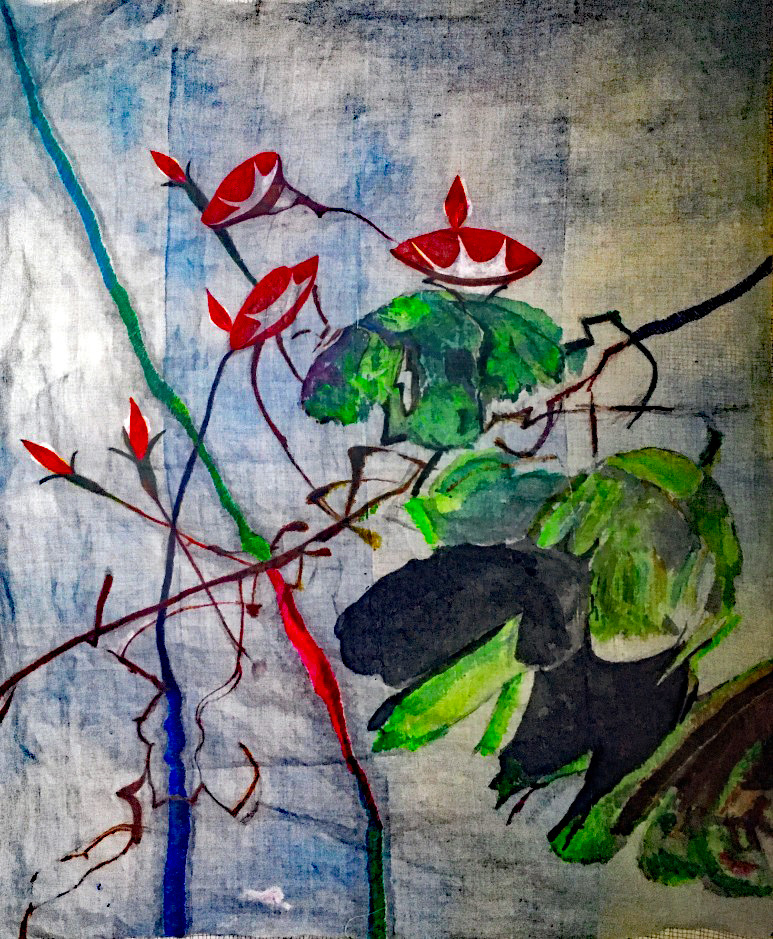
Louis Choi Chuljoo, thread painting: morning glory 2020-b, 135X156cm, acrylic and composite materials on cloth
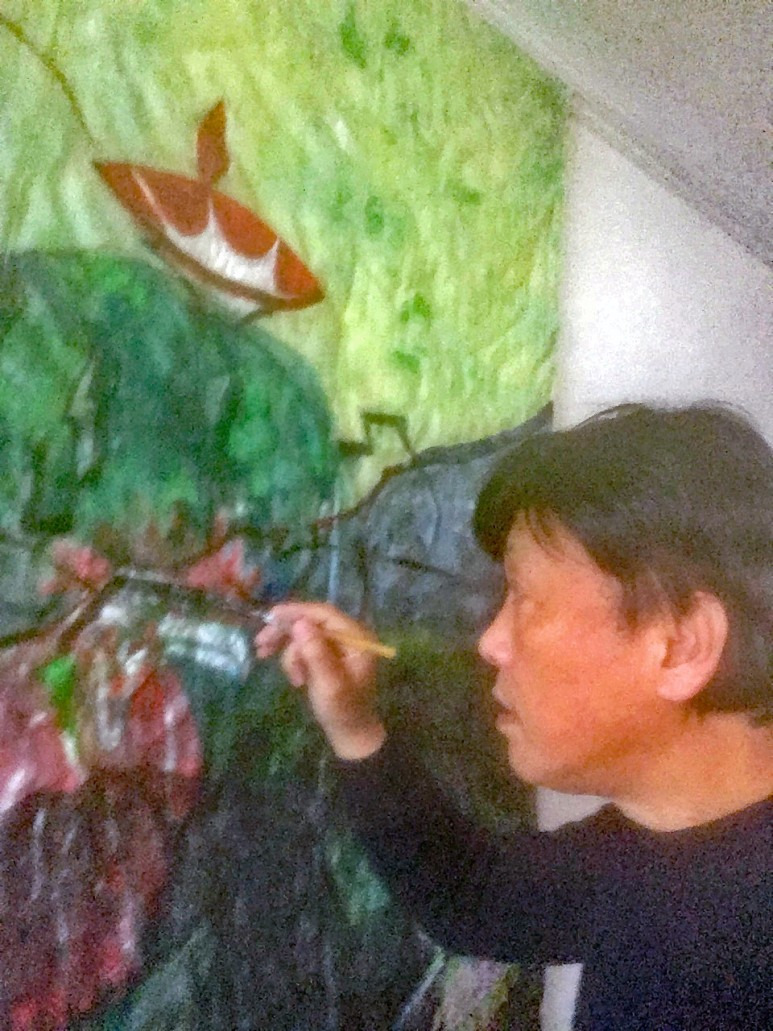
Media art and painting without description of the perspective structure of the atmosphere are realized through thread painting. Here, in the process of producing the original media art that is mechanically reproduced by perspective description, the form drawn by the other's desireful gaze is thread painting "morning glory B-00-2-1".
The image as a result of the performance of thread painting is <morning glory B-00-2-2> in the form of a painting cloth that is reflected on the back by manually painting the generated image of action painting to Process Art. In other words, Choi Chul-joo's <morning glory B-00-2> was an action painting with an object of desire concept and a desire cencept image of desire cencept's <morning glory> exhibition on December 22, 2021 at Gwangan Gallery as a performance of contemporary image installation artist and contemporary art artist Choi Chul-joo.
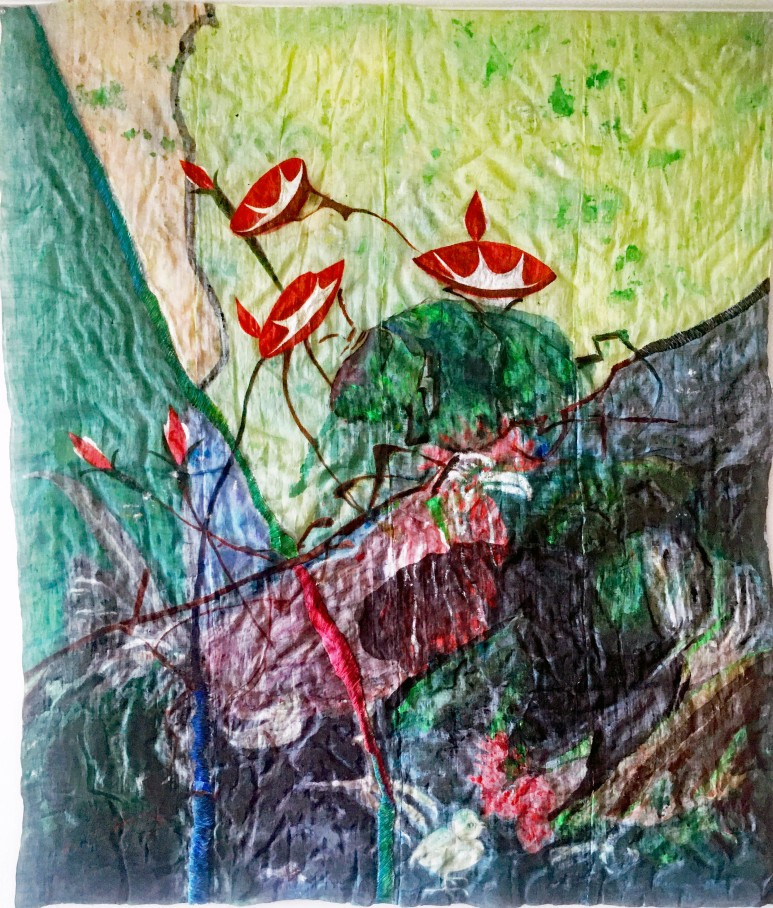
Louis Choi Chuljoo, thread painting: morning glory 2020-b → morning glory B-00-2-2
The image and color of thread painting in that form show the aesthetic value of the other's desire structure in a hidden shape by forming an imaginary formative structure of a faded desire without marking it by giving a distance of time.
This is a conceptual art based on Choi Chul-joo's desire concept abstract art theory, and the formality as a painting beyond literature was drawn in the structure of thread painting as a new formulation by drawing the image of desire left after the emergence of the concept of desire. It is a picture that reconstructs the formulation in which the concept of desire exists with a linear structure so that the formulation can be adjusted to a specific color like a knot blocking the color by putting the structure of the color into the thread.
Therefore, the concept of "Thread Painting" in which the structure of the thread is added as a color is painted on the structure of color in the concept of cloth and desire that pursues linear aesthetics as artistry of desire.
Thread painting 'morning glory B-00-2-2' is an image of the desire of the other painted on a cloth-like material against the background of the desire of the chick to convey the custom of seeing it as an infant in Choi Chul-ju's concept of desire.

Louis Choi Chuljoo, thread painting: morning glory B-00-2-2 → morning glory 2022-c, 135X156cm, acrylic and composite materials on cloth
In "morning glory B-00-2-2", a shape in which an object is seen, such as a desire image, is composed of a material such as fabric to generate an image in which the left and right sides are reversed. Therefore, his picture is a two-sided picture that does not distinguish between the front and the back. Here, a new picture emerges when the image on the back is converted to the front. This is a thread painting in which the image of a desire object that appears to be reversible light that rejects the center of the image of desire, which omits the volume of the chicken and replaces the reality that rejects perspective description.
The back of "morning glory B-00-2-2", "morning glory 2022-c", is a painting that has actually transformed into a system of notation for semantic representation. The painting reduces the planar dimensionality of "morning glory B-00-2-2" to the essence of meaning. This is a dual object that simultaneously shows everyday livestock and a family in a symbolic sense through chickens and chicks. The shape of the picture emerges the aesthetic meaning of the image of a desire structure that realistically depicts the concept of desire in the visual system in the thread painting where the image is installed.
This is a pictorial desire act that defines the object in perspective as a limited area, and produces the meaning of actualizing the back of thread painting by drawing the structure of distorted desire in the original space on the canvas.

The image of the shape of the object is created by embroidery, and the image of the cloth is expanded to embroidery, or the shape of the embroidery is transformed to widen the position of the cloth by flat painting.
This is conceptual image installation artist Choi Chul-joo's painting. As an installation of images, it is realized in flat painting without adding embroidery in media art and painting without description of the atmosphere.
Here, the shape drawn in the shade of reversible light and the thread painting in the small hole of the cloth are a picture that expands the position of the desire illuminated with reflected light.
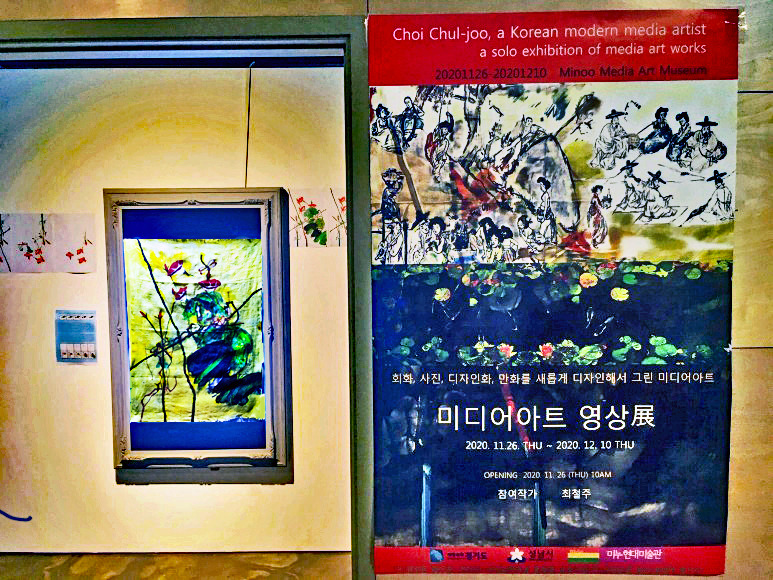
Louis Chul-joo Choi’s thread painting: morning glory B-06, 55X73cm, acrylic and composite materials on cloth, 2021/ *Extended exhibition period: 2020.12.11- 2021.1.29, Museum of Minoo media art museum

Louis Chul-joo Choi’s thread painting: morning glory B-06, 55X73cm, acrylic and composite materials on cloth, 2020
Louis Chul-joo Choi’s thread painting: morning glory B-06
In addition, thread painting, in which still images as media art images are drawn according to timeliness by having originality based on image of media art and the shape of process media art, has another originality of the original work. This is because it is a context that is shown on the monitor and is a circle drawn with thread painting each image that has been stopped. It is a formative thread image with the same artistic meaning as painting, showing various exhibition formats.
The timeliness reversible from physicality in the place of exhibition space creates a place as the color of light and is recognized as the color of light in that place.
The space of abstract light can give a glimpse into the structure of a material object, but the place becomes the margin of space in which the subject of the object follows the change of its temporality. The margin is an abstract space, but as the subject of painting is drawn in what it says is the color of reversible light, it creates a place for the object in the margin. This is the object position determined by the inevitability of the symmetrical space so that the painting matches the image of the light of the space against the object. The space of the image tailored to the target is a structure of a painting that creates a separate space that connects the gap in the form of cloth-like material, and draws the color of light by stitching several empty spaces and margins. The image depends on the color and shape determined by the object location. Thus, the color of the image embellishes the reality of conventional universality facing the object with the color of light. The dark space in contrast to the light in this decorated shape is a shadow that was stopped in one place and looked at. Here, as the real object, color is a fragmented figure of the enlightened custom seen as a gaze.
A painting was made by repeating a picture of the image of a enlightened object, which stopped in a customary place of life, as a color of light, and the color of the reflective margin, which is difficult to distinguish, on a cloth-like material. Color-painted paintings here unravel the existence of reality as the shape of the color when enlightened by custom or found in place.
However, the empty space in the margin cannot reproduce the timeliness, so it seems to be a color that suits the subject of the object. In contrast to the color of light, <the morning glory> which depicts the shape of a cloth-like thread, captures the familiarity of the customs as the inevitability of the past space.
The Conceptual Stage of Art Criticism by Louis Choi Chul-joo: Choi Chul-joo's Desire Concept Abstract Art Design Process is rooted in the Lacan Concept as a psychoanalytic theory and the step in his design process is to design the Desire Concept.
1. Expression of Reality Symbols on the Concept of Abstract Desire: It begins with conceptualizing the subject of desire as a conceptual sign from the object of abstract desire as a real image. Here, desire is designed by imagining the concept of abstract desire as a visual form representing the subject's unconscious desire.
2. Realizing Desire Correlation in Reversible Shades of Light: To create a dynamic interaction between reality and abstract desire concepts in reversible shading of light, Choi Chul-joo's Desire Formula is applied to design the correlation between desire concept and correlation.
3.Presenting Desire Background as Abstract Space: Using the Desire Background as a series of "Morning Glory," "Bamboo Forest," and "Pond," design that represents the structure of unconscious desire and the reality reflected in reality between the visible desire correlation and the hidden desire background.
4.Composing the linguistic desire structure into a real image: To express the concept of abstract desire as a linguistic desire structure as a real image, the abstract linguistic concept of desire structure is repeatedly designed as a real image to reflect the symbolic reality of the linguistic desire structure.
5. Visualization of Desire Structures in Cultural Context: To create works of art that acquire aesthetic value from desire structures so that they can empathize with cultural backgrounds, colors, forms, and compositions are put into practice by design.
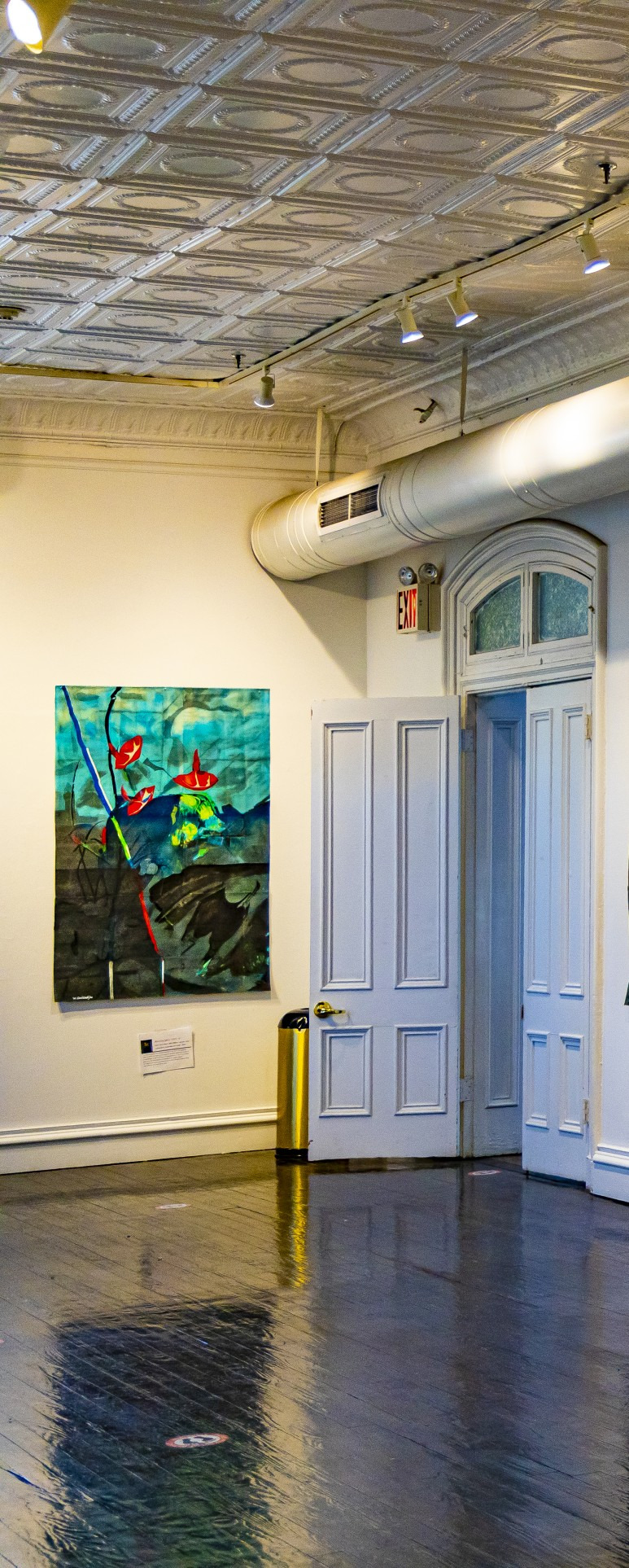
Louis, Chul-joo Choi, morning glory 2021-e, 114X169cm, acrylic and composite materials on cloth, 2021, / 20220301~20220308 Flushing Town Hall, New York.
As a conceptual abstraction, "morning glory 2021-e" outside the window is a conceptual image of desire drawn on a cloth with the back surface reflected by hand using a transformed image made of the actuality of the morning glory.
As a desirable structure of desire, the abstract poster of "morning glory" by Louis Choi Chul-joo, and related works of contemporary art desire are exhibited, which is a contemporary conceptual art abstract that symbolizes the design of desire, that is, the conceptual abstraction of painting, as a desirable desire structure.
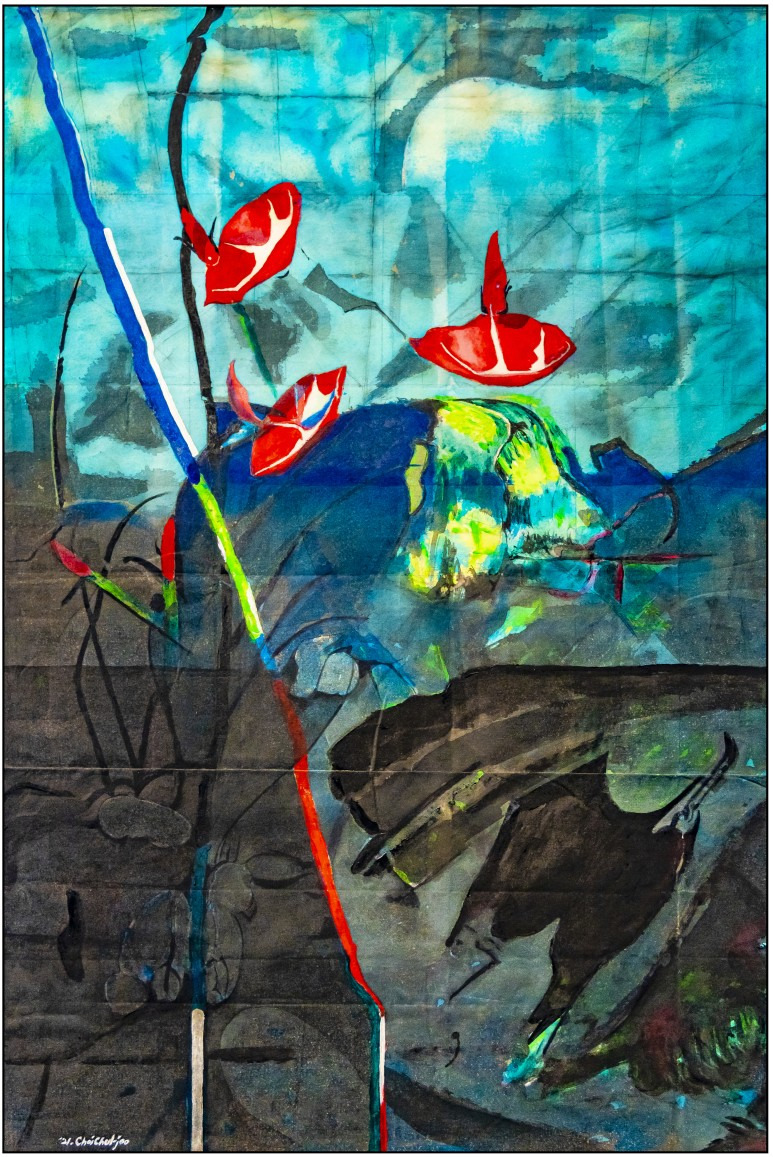
Louis, Chul-joo Choi, morning glory 2021-e, 114X169cm, acrylic and composite materials on cloth, 2021
An object (Louis Choi Chul-joo 2022 New York exhibition Morning glory 2021-e), which depicts the meaning of the figure in the semantic space created by the reversible light of non-realistic reality, structures the meaning of an abstract space that can reversibly transform the object into a real shape by concealing the other's desires in the shade of reversible light. The conceptual abstract meaning, or image in the mirror, is a virtual non-realistic image that reveals the place of the other's unconscious desires.
In response, Choi Chul-joo presents the design methodology of contemporary art.
This proceeds according to Choi Chul-joo's concept of desire formula. In other words, the image of desire applying Choi Chul-joo's desire formula D(I...I')d=I(D...D')i to 'morning glory' is an image that creates a landscape by floating a morning glory in the sky, and connects the concept of desire with the background of 'morning glory'. In addition, in "morning glory", the formula of desire is substituted "D(I...I')d=I(D'D'i" and the connection effect between the concept of desire and 'morning glory' as an image of desire sets the object as the concept of the image of desire by 'morning glory' to shade the concept of desire in a reversible shadow structure. In other words, the image of desire (I) is the structure of desire because desire (D) is repeated in several images (D...D), and the image of artistic action or desire (I) appears as the concept of desire (I).
Choi Chul-joo's Desire Object is an object (morning glory 2021-e) that depicts the meaning of the shape seen in the meaning space created by reversible light. By abstracting the image hidden in the long time period where the desire of the other is shared, the chick structure the meaning of a certain shape in the place of desire reflected in the shadow of reversible light to mean an abstract space that can reversible the object into its actual shape, and Choi Chul-joo refers to the concept of desire, which is covered by actual changed movements, in the shape of 100 exhibition posters set as the place of desire in the abstract space at the 2020 New York exhibition.
This is a dwarf planarity that seems to have a consistent meaning of "morning glory" in painting. The "morning glory" is an abstract place of desire that is the same as the reality in the mirror, but the shape of the background of desire is not the same.
Abstraction as a conceptual semantic structure is abstraction as a conceptual semantic structure of a non-realistic form with the same meaning as a conceptual form, but abstraction as the same meaning with different shapes is an actual non-realistic being with different colors and sizes. However, Choi Chul-joo reconstructs the abstract structure of desire into a real image as a conceptual object.
Its existence defines abstract space as a real reversible shape and mentions the abstract meaning of conceptual art through Choi Chul-joo's "morning glory" exhibition poster, which is set in the hope that the shape will be covered by actual movement in the shade of reversible light.

Chul-joo Choi's "morning glory": Exhibition of Louis Chul-joo Choi's "morning glory" with the image of Lacan's object ɑ and Picasso's Anamorphosis, 20.-22. Dec.2021 Gwangan Gallery in Busan.
The image that is out of line with reality as a desire object is consistent with the visualization of a photographic image in collage. This is because it is an image created by the desire of the other with a gaze area regardless of whether it is flat or three-dimensional. In "morning glory 2021-e-back", the morning glory in the lower center of the three morning glory as an object is a dwarf image, and the object of the structure of desire is seen as a gaze. Here, the morning glory refers to the existence of desire stopped by instantaneous gaze in the continuity of reversible time.

Chul-joo Choi, morning glory 2021-e-back, 114X169cm, acrylic and composite materials on cloth, 2021
The image in <morning glory 2021-e-back> shows the existence of reversible temporality by flattening the morning glory according to the perspective visual system margin and the reversible temporality, not the actual object.
However, although the existence of the morning glory is reproduced, the morning glory is confirmed by the background image, but it does not match the object of the desire structure. It is the semantic structure of a shadow created by reversible light whose image is different from that of a morning glory in terms of what existence is. It is an object as a being with a reversible temporality that is different from the non-existent shadow.
Therefore, the object is not an image as a subject, but as a being through the desire of others.
The morning glory at the bottom of the center connects reversible light to determine the place of existence and form the process of time and the space in which it exists. The morning glory formed at one light source point of view does not have good sense. Here, the morning glory is a partial fragmented image like a collage. In this way, each partial image exists in the space as the fragmented shape is exposed at the same time.
The flattened morning glory is the image of the subject created by the observer's gaze. It extracts the existence connected by a single color of reversible light through the morning glory that removes positive sensations, and contrasts the morning glory as an external image with the shadows of reversible light in the background from a perceptual point of view, showing a plane view transformed into a desire image.
The perspective of the concept of desire cannot be selected as a visible image that reproduces objects in reality and in reality depending on the viewpoint of view, and Choi Cheol-joo's photographic image that expresses the real image is identified as an image as in reality. Therefore, in an object, existence is a desire image as a reality similar to the object of the concept of desire.
Therefore, the desire gaze to see the shades created by reversible light reproduces the real and non-real objects according to the viewing point of view. The structure of the shade cannot be selected as a visible image, but it refers to the meaning of the concept by looking at the concept as an actual image that reverses the desires of others. And the concept of desire is identified as an image as a non-real world like a cartoon criticism. In other words, the existence of a desire object seems to be a sketch image similar to the reality of desire.

Louis Chul-joo Choi, morning glory 2025-2-Desire structure of objects in a pond reflected by reversible white light, 113X165cm, acrylic and composite materials on cloth, 2025
Choi Chul-joo's concept of desire, or modern art, appears, and a painting that conflicts with the concept of linguistic meaning emphasized by metaphysical and philosophical light creates a dramatic event image with artificial lighting.
Linguistic representation images as objects represent abstract meanings that represent words unrelated to grammatical sentence interpretation as event images. However, grammar gives logical meaning to abstract nonverbal behavior.
Thus, interpreting the concept of desire as a grammatical linguistic structure requires the design of abstract symbols in linguistic meaning repeatedly.
Images identical to the concept of desire produce images as the presence of objects when clearly defined through consciousness and conceptual design.
Choi Chul-joo's concept of desire, "morning glory," conflicts with linguistic concepts of meaning emphasized from a metaphysical philosophical point of view, creating dramatic event images to express the subject of insufficient desire, and illuminating the image in reversible shades of white light. He reflects the linguistic grammatical meaning of abstract desire concepts as images to form spaces of multiple event images that share superimposed temporality and reversible white light shades. This is interpreted as the subject of the absence of desire beyond the abstract self of the desire of others rather than physical perception, unlike the materialism of painting in the 18th century.
The linguistic grammatical meaning of abstract desire concepts is a dualistic object that regards real images as events, equating the structure of insufficient desire with the principle of spatial composition. And as reversible light at the point of light over time, the material is made into a real image as an object.
Thus, the concept of abstract desire in a pond that reflects the image of an event is expressed as a real image that reflects the desires of others in the real world.
Desire structure of objects in a pond reflected by reversible white light,
As an object of the concept of desire, the light discoloration as a reversible light overlapping the surface color contrast effect of the event image reflects the event image hiding the desire hidden in the reversible light projected into the pond, representing the shadow color of the desire structure like a spectrum.
The concept of abstract desire through the desire of the other constitutes the subject of desire lacking as a symbolic structure.
This is the result of being divided from symbolic existence by repeating the design according to Choi Chul-joo's desire formula to create the image that the subject aims for, and the real image appears as the subject with the concept of desire lacking the event image.
In Choi Chul-joo's desire structure, the shadow of reality in the shadow of reversible light results in a phenomenal image as a sign of the unconscious desire of the other in the line space in the direction of the gaze of the event image.
This is the shade created after the object because the circular object of the concept of the other's desire is hidden by light.
In the object's desire structure in the pond reflected by reversible white light, the subject of deficient desire imaginatively equates the event image reflected in the pond with the concept of abstract desire to constitute the subject of deficient desire.
The event image reflected in the pond creates a real image with the same meaning by stating the concept of insufficient desire as a conscious movement.
Here, in the desire structure, the shadow is a composition lacking in the other's desire structure, and the event image is carved and obscured.
This is a shadow created by being blocked by actions induced by the opaque cause of desire in the image of reality as a structure of unconscious desire.

In the concept of Choi Chul-joo's desire, reversible light, whose altitude and direction are not specified, shows reality as a being according to temporality.
It refers to the real image as the existence of reversible light that identifies the traumatic image of the event image as the structure of the desire of the object in the pond reflected by the reversible white light.
This is a desire object that realizes abstract desire by representing reality that represents the linguistic meaning of the concept of desire as a shaded image of reversible light.
The object repeatedly expresses the linguistic meaning of the concept of desire as a real image by repeating the design through conscious movement that identifies the image of the event and the reality that symbolizes the lack of desire.
And while determining the relationship between the real image and the subject of desire, the subject transitions to the real image so that the subject cannot imagine the concept of desire. It provides the cause of causing the phenomenon of desire as an event image, from the real image that the subject cannot return to the concept of desire as an object of desire.
Here, the object that causes the phenomenon of desire is Choi Chul-joo's desire formula, repeating the design to create a real image as a linguistic meaning of the concept of abstract desire, and abstracting the meaning of desire lacking the image.
In the shaded image, the object turns red as the white light as a being that has stopped in time is absorbed into the background, and the blue, green, and yellow colors that are absorbed into the morning glory background are the same shaded structural colors as the desire background of the 'morning glory'. Here, the contrast effect visible from the visual system is the color of the absorption spectrum in which the color reflected from the object changing light is projected onto the pond.
This means that abstract desire changes from the natural real color of a real object to the concept of desire as a linguistic meaning, and like the chemical reaction of reversible white light, the shadow of the morning glory defines desire by designating white light as the color of desire, and is parallel without distorting the size of the shadow like the sun light.
Therefore, it is expressed in flat red regardless of the direction of the light. A bright shadow diffracted by light consists of an overall reversible shade of light, which is not distorted into the shape of an object. This painting is actually painted using the light of the sun as a light, just like an ink-and-wash painting.
Abstracting the meaning of desire that lacks an event image as an object of the desire structure of an object in a pond reflected by reversible white light, the reality in the shadow of reversible sunlight supports abstract desire. Additionally, the concept of lack of desire is linguistic consciousness, creating a reality that exists in the line space that specifies the place of desire./ Writing. Choi Chul-joo, Contemporary Art Design Critic (Conceptual Abstract Painter & Doctor of Cultural Design)

Contemporary media art work: Louis Chul-joo Choi’s thread painting: morning glory
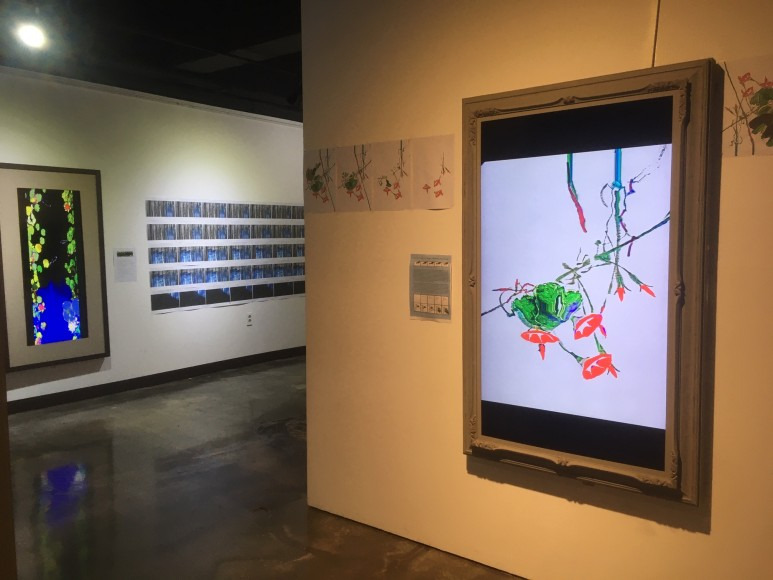
Louis Chul-joo Choi’s thread painting: morning glory, 2021/ *Extended exhibition period: 2020.12.11- 2021.1.29, Museum of Minoo media art museum
